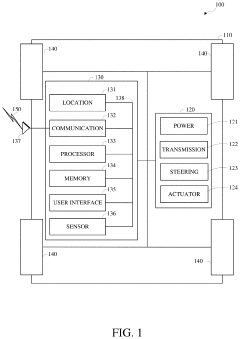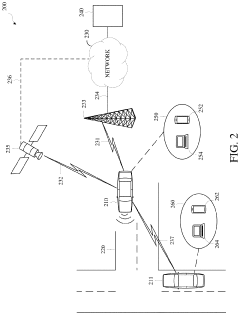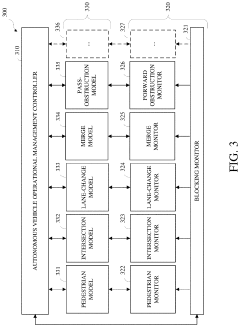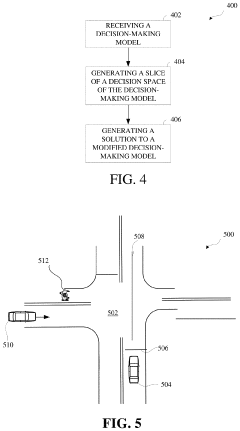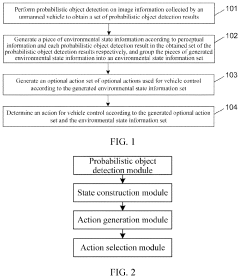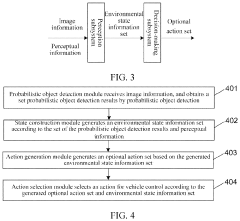Throttle Body Optimization for Autonomous Decision-Making Systems
JUL 18, 20259 MIN READ
Generate Your Research Report Instantly with AI Agent
Patsnap Eureka helps you evaluate technical feasibility & market potential.
Throttle Body Tech Evolution and Objectives
The throttle body has been a crucial component in internal combustion engines for decades, controlling the amount of air entering the engine and thus regulating engine power and efficiency. In recent years, the evolution of throttle body technology has taken a significant leap forward, driven by the increasing demand for autonomous decision-making systems in vehicles.
The traditional mechanical throttle bodies have given way to electronic throttle control (ETC) systems, also known as drive-by-wire technology. This transition marked a pivotal moment in throttle body evolution, enabling more precise control and integration with advanced vehicle systems. The ETC system replaced the physical connection between the accelerator pedal and the throttle with electronic sensors and actuators, allowing for more sophisticated engine management.
As autonomous vehicles began to emerge, the role of the throttle body became even more critical. The integration of throttle control with autonomous decision-making systems required a new level of precision and responsiveness. This led to the development of smart throttle bodies, capable of real-time adjustments based on a multitude of inputs from various vehicle sensors and control units.
The objectives of throttle body optimization for autonomous systems are multifaceted. Primarily, there is a focus on enhancing the accuracy and speed of throttle response to match the rapid decision-making capabilities of autonomous systems. This involves minimizing latency between the command input and the actual throttle movement, ensuring that the vehicle can react swiftly to changing road conditions or unexpected obstacles.
Another key objective is to improve the overall efficiency of the engine. By optimizing throttle control, autonomous systems can achieve better fuel economy and reduced emissions, aligning with increasingly stringent environmental regulations. This optimization extends to various driving scenarios, from city traffic to highway cruising, where different throttle strategies may be employed to maximize efficiency.
Reliability and fault tolerance have also become paramount in throttle body development for autonomous vehicles. The system must be capable of detecting and compensating for potential failures, ensuring safe operation even in the event of component malfunction. This has led to the implementation of redundant systems and fail-safe mechanisms within the throttle body design.
Furthermore, the integration of machine learning algorithms into throttle control systems represents a significant technological goal. These algorithms can analyze vast amounts of data from previous driving experiences to predict optimal throttle positions for various scenarios, continuously improving the vehicle's performance and efficiency over time.
As the automotive industry moves towards higher levels of autonomy, the evolution of throttle body technology continues to focus on seamless integration with other vehicle systems. This includes coordination with regenerative braking systems in electric and hybrid vehicles, as well as advanced traction control and stability management systems. The ultimate aim is to create a holistic approach to vehicle control, where the throttle body plays a central role in executing the complex decisions made by autonomous driving algorithms.
The traditional mechanical throttle bodies have given way to electronic throttle control (ETC) systems, also known as drive-by-wire technology. This transition marked a pivotal moment in throttle body evolution, enabling more precise control and integration with advanced vehicle systems. The ETC system replaced the physical connection between the accelerator pedal and the throttle with electronic sensors and actuators, allowing for more sophisticated engine management.
As autonomous vehicles began to emerge, the role of the throttle body became even more critical. The integration of throttle control with autonomous decision-making systems required a new level of precision and responsiveness. This led to the development of smart throttle bodies, capable of real-time adjustments based on a multitude of inputs from various vehicle sensors and control units.
The objectives of throttle body optimization for autonomous systems are multifaceted. Primarily, there is a focus on enhancing the accuracy and speed of throttle response to match the rapid decision-making capabilities of autonomous systems. This involves minimizing latency between the command input and the actual throttle movement, ensuring that the vehicle can react swiftly to changing road conditions or unexpected obstacles.
Another key objective is to improve the overall efficiency of the engine. By optimizing throttle control, autonomous systems can achieve better fuel economy and reduced emissions, aligning with increasingly stringent environmental regulations. This optimization extends to various driving scenarios, from city traffic to highway cruising, where different throttle strategies may be employed to maximize efficiency.
Reliability and fault tolerance have also become paramount in throttle body development for autonomous vehicles. The system must be capable of detecting and compensating for potential failures, ensuring safe operation even in the event of component malfunction. This has led to the implementation of redundant systems and fail-safe mechanisms within the throttle body design.
Furthermore, the integration of machine learning algorithms into throttle control systems represents a significant technological goal. These algorithms can analyze vast amounts of data from previous driving experiences to predict optimal throttle positions for various scenarios, continuously improving the vehicle's performance and efficiency over time.
As the automotive industry moves towards higher levels of autonomy, the evolution of throttle body technology continues to focus on seamless integration with other vehicle systems. This includes coordination with regenerative braking systems in electric and hybrid vehicles, as well as advanced traction control and stability management systems. The ultimate aim is to create a holistic approach to vehicle control, where the throttle body plays a central role in executing the complex decisions made by autonomous driving algorithms.
Market Demand for Autonomous Throttle Systems
The market demand for autonomous throttle systems has been experiencing significant growth in recent years, driven by the increasing adoption of autonomous and semi-autonomous vehicles across various industries. This surge in demand is primarily fueled by the automotive sector, where advanced driver assistance systems (ADAS) and autonomous driving technologies are becoming standard features in modern vehicles.
In the passenger vehicle segment, major automakers are integrating autonomous throttle systems as part of their ADAS packages, aiming to enhance safety, improve fuel efficiency, and provide a more comfortable driving experience. The commercial vehicle sector is also showing strong interest in these systems, particularly for long-haul trucking applications, where autonomous throttle control can lead to substantial fuel savings and reduced driver fatigue.
Beyond the automotive industry, autonomous throttle systems are finding applications in other sectors such as agriculture, construction, and mining. In these industries, the technology is being utilized to optimize machine operations, increase productivity, and improve safety in challenging environments.
The market for autonomous throttle systems is expected to grow at a compound annual growth rate (CAGR) of over 20% in the next five years. This growth is supported by favorable government regulations promoting vehicle safety and emissions reduction, as well as increasing consumer awareness and acceptance of autonomous technologies.
Key market drivers include the push for improved vehicle efficiency, the need for enhanced safety features, and the ongoing development of fully autonomous vehicles. As these systems become more sophisticated and capable of handling complex decision-making scenarios, their adoption is likely to accelerate across various industries.
However, the market also faces challenges, such as high initial costs, concerns about system reliability and security, and the need for standardization across different platforms and manufacturers. Overcoming these hurdles will be crucial for the widespread adoption of autonomous throttle systems.
In terms of regional demand, North America and Europe currently lead the market, with Asia-Pacific expected to show the fastest growth in the coming years. This growth in Asia-Pacific is attributed to the rapid industrialization, increasing vehicle production, and government initiatives supporting autonomous vehicle technologies in countries like China, Japan, and South Korea.
As the technology continues to evolve, there is a growing demand for more advanced and intelligent throttle systems that can seamlessly integrate with other vehicle systems and adapt to various driving conditions. This trend is driving research and development efforts towards creating more robust, efficient, and responsive autonomous throttle solutions.
In the passenger vehicle segment, major automakers are integrating autonomous throttle systems as part of their ADAS packages, aiming to enhance safety, improve fuel efficiency, and provide a more comfortable driving experience. The commercial vehicle sector is also showing strong interest in these systems, particularly for long-haul trucking applications, where autonomous throttle control can lead to substantial fuel savings and reduced driver fatigue.
Beyond the automotive industry, autonomous throttle systems are finding applications in other sectors such as agriculture, construction, and mining. In these industries, the technology is being utilized to optimize machine operations, increase productivity, and improve safety in challenging environments.
The market for autonomous throttle systems is expected to grow at a compound annual growth rate (CAGR) of over 20% in the next five years. This growth is supported by favorable government regulations promoting vehicle safety and emissions reduction, as well as increasing consumer awareness and acceptance of autonomous technologies.
Key market drivers include the push for improved vehicle efficiency, the need for enhanced safety features, and the ongoing development of fully autonomous vehicles. As these systems become more sophisticated and capable of handling complex decision-making scenarios, their adoption is likely to accelerate across various industries.
However, the market also faces challenges, such as high initial costs, concerns about system reliability and security, and the need for standardization across different platforms and manufacturers. Overcoming these hurdles will be crucial for the widespread adoption of autonomous throttle systems.
In terms of regional demand, North America and Europe currently lead the market, with Asia-Pacific expected to show the fastest growth in the coming years. This growth in Asia-Pacific is attributed to the rapid industrialization, increasing vehicle production, and government initiatives supporting autonomous vehicle technologies in countries like China, Japan, and South Korea.
As the technology continues to evolve, there is a growing demand for more advanced and intelligent throttle systems that can seamlessly integrate with other vehicle systems and adapt to various driving conditions. This trend is driving research and development efforts towards creating more robust, efficient, and responsive autonomous throttle solutions.
Current Challenges in Throttle Body Optimization
Throttle body optimization in autonomous decision-making systems faces several significant challenges that hinder its widespread implementation and effectiveness. One of the primary obstacles is the complexity of real-time data processing and analysis. Autonomous systems require instantaneous decision-making capabilities, which demand high-speed computation and low-latency responses from throttle bodies. The sheer volume of data generated by various sensors and the need for its immediate interpretation pose a substantial challenge to current throttle body designs.
Another critical challenge lies in the integration of throttle body systems with other autonomous vehicle components. Achieving seamless communication and coordination between the throttle body and other subsystems, such as braking, steering, and navigation, is crucial for optimal performance. This integration becomes even more complex when considering the diverse range of vehicle types and their specific requirements, necessitating adaptive and flexible throttle body solutions.
The variability of environmental conditions presents yet another hurdle in throttle body optimization. Autonomous systems must be capable of adjusting throttle responses to accommodate diverse weather conditions, road surfaces, and traffic scenarios. This adaptability requirement significantly complicates the design and calibration processes of throttle bodies, as they must maintain consistent performance across a wide spectrum of operating conditions.
Ensuring the reliability and safety of throttle body systems in autonomous vehicles is paramount. The potential consequences of throttle body failure or malfunction in an autonomous system are severe, necessitating robust fail-safe mechanisms and redundancy measures. Developing these safety features while maintaining system efficiency and responsiveness presents a significant engineering challenge.
Energy efficiency and environmental considerations also play a crucial role in throttle body optimization. As the automotive industry shifts towards more sustainable practices, throttle bodies must be designed to minimize fuel consumption and emissions without compromising vehicle performance. This balancing act between efficiency and functionality adds another layer of complexity to the optimization process.
Lastly, the regulatory landscape surrounding autonomous vehicles is still evolving, creating uncertainty in design and implementation standards for throttle body systems. Compliance with emerging regulations and standards across different jurisdictions requires a flexible approach to throttle body design, further complicating the optimization process. Manufacturers must anticipate and adapt to potential regulatory changes while developing their throttle body technologies.
Another critical challenge lies in the integration of throttle body systems with other autonomous vehicle components. Achieving seamless communication and coordination between the throttle body and other subsystems, such as braking, steering, and navigation, is crucial for optimal performance. This integration becomes even more complex when considering the diverse range of vehicle types and their specific requirements, necessitating adaptive and flexible throttle body solutions.
The variability of environmental conditions presents yet another hurdle in throttle body optimization. Autonomous systems must be capable of adjusting throttle responses to accommodate diverse weather conditions, road surfaces, and traffic scenarios. This adaptability requirement significantly complicates the design and calibration processes of throttle bodies, as they must maintain consistent performance across a wide spectrum of operating conditions.
Ensuring the reliability and safety of throttle body systems in autonomous vehicles is paramount. The potential consequences of throttle body failure or malfunction in an autonomous system are severe, necessitating robust fail-safe mechanisms and redundancy measures. Developing these safety features while maintaining system efficiency and responsiveness presents a significant engineering challenge.
Energy efficiency and environmental considerations also play a crucial role in throttle body optimization. As the automotive industry shifts towards more sustainable practices, throttle bodies must be designed to minimize fuel consumption and emissions without compromising vehicle performance. This balancing act between efficiency and functionality adds another layer of complexity to the optimization process.
Lastly, the regulatory landscape surrounding autonomous vehicles is still evolving, creating uncertainty in design and implementation standards for throttle body systems. Compliance with emerging regulations and standards across different jurisdictions requires a flexible approach to throttle body design, further complicating the optimization process. Manufacturers must anticipate and adapt to potential regulatory changes while developing their throttle body technologies.
Existing Throttle Optimization Solutions
01 Throttle body design optimization
Optimizing the design of throttle bodies to improve airflow and engine performance. This includes modifications to the shape, size, and internal components of the throttle body to enhance efficiency and responsiveness.- Throttle body design optimization: Optimizing the design of throttle bodies to improve airflow and engine performance. This includes modifications to the shape, size, and internal components of the throttle body to enhance efficiency and responsiveness.
- Electronic throttle control systems: Implementation of electronic throttle control systems to improve precision and responsiveness. These systems use sensors and actuators to regulate airflow more accurately, enhancing overall engine performance and fuel efficiency.
- Throttle body airflow management: Techniques for managing airflow through the throttle body, including the use of variable geometry designs and advanced flow control mechanisms. These improvements aim to optimize air intake across different engine operating conditions.
- Integration with engine management systems: Enhancing the integration of throttle bodies with engine management systems for improved overall performance. This includes advanced sensors, data processing, and adaptive control algorithms to optimize throttle response based on various engine parameters.
- Material and manufacturing improvements: Advancements in materials and manufacturing processes for throttle bodies, focusing on reducing weight, improving durability, and enhancing thermal management. This includes the use of advanced alloys and precision manufacturing techniques.
02 Electronic throttle control systems
Implementation of electronic throttle control systems to improve precision and responsiveness. These systems use sensors and actuators to regulate airflow more accurately, enhancing overall engine performance and fuel efficiency.Expand Specific Solutions03 Throttle body airflow management
Techniques for managing airflow through the throttle body, including the use of variable geometry designs and advanced valve systems. These innovations aim to optimize air intake across different engine operating conditions.Expand Specific Solutions04 Integration with engine management systems
Integrating throttle body optimization with broader engine management systems. This approach involves coordinating throttle control with other engine parameters to achieve optimal performance, fuel efficiency, and emissions control.Expand Specific Solutions05 Material and manufacturing improvements
Advancements in materials and manufacturing processes for throttle bodies. This includes the use of lightweight materials, precision manufacturing techniques, and surface treatments to enhance durability and performance.Expand Specific Solutions
Key Players in Autonomous Throttle Systems
The throttle body optimization for autonomous decision-making systems market is in its growth stage, with increasing adoption of autonomous technologies across various industries. The market size is expanding rapidly, driven by the automotive sector's push towards autonomous vehicles and the integration of AI-driven decision-making systems in industrial applications. Technologically, the field is advancing quickly, with companies like GM Global Technology Operations LLC, Nissan Motor Co., Ltd., and DENSO Corp. leading innovation in automotive applications. JFE Steel Corp. and Aisan Industry Co., Ltd. are contributing to component development, while tech giants like IBM Corp. are providing AI and data processing capabilities. The involvement of diverse players indicates a maturing ecosystem, though challenges in standardization and real-world implementation remain.
GM Global Technology Operations LLC
Technical Solution: GM has developed an advanced throttle body optimization system for autonomous decision-making systems. Their approach utilizes machine learning algorithms to continuously adapt throttle response based on real-time driving conditions and vehicle performance data. The system incorporates a neural network that processes inputs from various sensors, including speed, acceleration, and road conditions, to optimize fuel efficiency and performance[1]. GM's technology also features predictive modeling to anticipate upcoming driving scenarios and adjust throttle behavior accordingly, enhancing both safety and efficiency in autonomous vehicles[3].
Strengths: Adaptive learning capabilities, integration with existing GM autonomous systems, and potential for improved fuel efficiency. Weaknesses: May require significant computational resources and extensive real-world testing for validation.
Nissan Motor Co., Ltd.
Technical Solution: Nissan has implemented a novel throttle body optimization system for their autonomous vehicles, focusing on seamless integration with their ProPILOT technology. Their approach uses a combination of AI and traditional control systems to fine-tune throttle response. The system employs a multi-layer perceptron neural network to predict optimal throttle positions based on various inputs, including vehicle speed, road grade, and traffic conditions[2]. Nissan's technology also incorporates a unique "eco-mode" that prioritizes fuel efficiency in autonomous driving scenarios, dynamically adjusting throttle sensitivity to minimize unnecessary acceleration and deceleration[4].
Strengths: Seamless integration with existing autonomous driving systems, focus on fuel efficiency. Weaknesses: May be overly conservative in performance-oriented driving scenarios.
Core Innovations in Throttle Body Design
Apparatus and method for post-processing a decision-making model of an autonomous vehicle using multivariate data
PatentActiveUS11782438B2
Innovation
- The proposed solution involves post-processing decision-making models using multivariate data to generate slices of the decision space by modifying values of specific observations, allowing for the generation of alternative solutions and modifying probabilistic transition or observation matrices within the models, particularly for Partially Observable Markov Decision Process (POMDP) models.
Method, apparatus, computer storage medium and terminal for implementing autonomous driving decision-making
PatentActiveUS11673562B1
Innovation
- A method that performs probabilistic object detection on image information from unmanned vehicles, generates environmental state information, and determines vehicle control actions using a hybrid decision-making framework that considers uncertainty, ensuring safety by accounting for potential inaccuracies in perception results.
Safety and Reliability Considerations
Safety and reliability are paramount considerations in the optimization of throttle bodies for autonomous decision-making systems. The integration of these systems into vehicles necessitates a comprehensive approach to ensure the safety of passengers, pedestrians, and other road users. One of the primary concerns is the potential for system failures or malfunctions that could lead to unintended acceleration or deceleration. To mitigate these risks, redundant safety mechanisms are often implemented, including multiple sensors and fail-safe protocols that can detect anomalies and initiate appropriate responses.
The reliability of throttle body systems in autonomous vehicles is closely tied to their ability to perform consistently under various environmental conditions. Factors such as temperature fluctuations, humidity, and altitude changes can affect the performance of electronic throttle control systems. Engineers must design robust systems that can maintain accuracy and responsiveness across a wide range of operating conditions. This often involves extensive testing in simulated environments and real-world scenarios to validate the system's reliability.
Cybersecurity is another critical aspect of safety and reliability in autonomous throttle control systems. As these systems become increasingly connected and reliant on software, they become potential targets for cyber attacks. Implementing strong encryption protocols, secure over-the-air update mechanisms, and intrusion detection systems is essential to protect against unauthorized access or manipulation of the throttle control system.
The integration of artificial intelligence and machine learning algorithms in throttle body optimization introduces new challenges in terms of safety validation. Traditional testing methods may not be sufficient to cover all possible scenarios that an AI-driven system might encounter. As a result, new approaches to safety verification, such as formal methods and scenario-based testing, are being developed to ensure the robustness of autonomous decision-making systems.
Regulatory compliance is a key consideration in the development of safe and reliable throttle body systems for autonomous vehicles. Manufacturers must adhere to stringent safety standards and regulations, which often vary across different regions and jurisdictions. This requires a thorough understanding of the regulatory landscape and the ability to design systems that meet or exceed these requirements while still delivering optimal performance.
Long-term reliability and durability are essential factors in the overall safety of autonomous throttle control systems. Components must be designed to withstand the rigors of daily use over the expected lifespan of the vehicle. This includes considerations such as wear resistance, corrosion protection, and the ability to maintain calibration over time. Predictive maintenance strategies, enabled by advanced sensors and data analytics, can help identify potential issues before they lead to system failures, further enhancing the safety and reliability of these critical components.
The reliability of throttle body systems in autonomous vehicles is closely tied to their ability to perform consistently under various environmental conditions. Factors such as temperature fluctuations, humidity, and altitude changes can affect the performance of electronic throttle control systems. Engineers must design robust systems that can maintain accuracy and responsiveness across a wide range of operating conditions. This often involves extensive testing in simulated environments and real-world scenarios to validate the system's reliability.
Cybersecurity is another critical aspect of safety and reliability in autonomous throttle control systems. As these systems become increasingly connected and reliant on software, they become potential targets for cyber attacks. Implementing strong encryption protocols, secure over-the-air update mechanisms, and intrusion detection systems is essential to protect against unauthorized access or manipulation of the throttle control system.
The integration of artificial intelligence and machine learning algorithms in throttle body optimization introduces new challenges in terms of safety validation. Traditional testing methods may not be sufficient to cover all possible scenarios that an AI-driven system might encounter. As a result, new approaches to safety verification, such as formal methods and scenario-based testing, are being developed to ensure the robustness of autonomous decision-making systems.
Regulatory compliance is a key consideration in the development of safe and reliable throttle body systems for autonomous vehicles. Manufacturers must adhere to stringent safety standards and regulations, which often vary across different regions and jurisdictions. This requires a thorough understanding of the regulatory landscape and the ability to design systems that meet or exceed these requirements while still delivering optimal performance.
Long-term reliability and durability are essential factors in the overall safety of autonomous throttle control systems. Components must be designed to withstand the rigors of daily use over the expected lifespan of the vehicle. This includes considerations such as wear resistance, corrosion protection, and the ability to maintain calibration over time. Predictive maintenance strategies, enabled by advanced sensors and data analytics, can help identify potential issues before they lead to system failures, further enhancing the safety and reliability of these critical components.
Integration with Vehicle AI Systems
The integration of throttle body optimization with vehicle AI systems represents a critical advancement in autonomous decision-making for automotive applications. This integration enables a more sophisticated and responsive control of the vehicle's powertrain, enhancing overall performance and efficiency. By leveraging artificial intelligence, the throttle body can adapt in real-time to various driving conditions, traffic patterns, and environmental factors.
One of the key aspects of this integration is the development of predictive algorithms that anticipate throttle position requirements based on a multitude of inputs. These inputs include not only traditional sensor data such as vehicle speed, engine load, and accelerator pedal position but also advanced AI-processed information from cameras, radar, and LiDAR systems. This holistic approach allows for smoother acceleration, improved fuel economy, and enhanced safety in autonomous driving scenarios.
Machine learning models play a crucial role in optimizing throttle body performance within AI-driven vehicles. These models can be trained on vast amounts of driving data to recognize patterns and make split-second decisions on optimal throttle positioning. Over time, the system can learn and adapt to individual driving styles and preferences, creating a personalized driving experience even in autonomous mode.
The integration also facilitates more advanced features such as predictive cruise control and eco-driving modes. By analyzing upcoming road conditions, traffic flow, and even weather patterns, the AI system can adjust the throttle body to maintain optimal speed and efficiency. This proactive approach not only improves fuel economy but also reduces wear on the vehicle's components.
Furthermore, the integration of throttle body optimization with vehicle AI systems enables more sophisticated traction control and stability management. By precisely controlling the engine's power output through the throttle body, the AI can respond more quickly and accurately to changes in road conditions or sudden maneuvers, enhancing vehicle safety and handling.
Cybersecurity considerations are paramount in this integration, as the throttle body becomes part of the vehicle's connected ecosystem. Robust encryption and authentication protocols must be implemented to prevent unauthorized access or manipulation of the throttle control systems, ensuring the safety and integrity of the autonomous vehicle's operations.
As vehicle AI systems continue to evolve, the role of throttle body optimization will likely expand. Future developments may include more advanced integration with vehicle-to-vehicle (V2V) and vehicle-to-infrastructure (V2I) communication systems, allowing for even more precise and coordinated throttle control in complex traffic scenarios.
One of the key aspects of this integration is the development of predictive algorithms that anticipate throttle position requirements based on a multitude of inputs. These inputs include not only traditional sensor data such as vehicle speed, engine load, and accelerator pedal position but also advanced AI-processed information from cameras, radar, and LiDAR systems. This holistic approach allows for smoother acceleration, improved fuel economy, and enhanced safety in autonomous driving scenarios.
Machine learning models play a crucial role in optimizing throttle body performance within AI-driven vehicles. These models can be trained on vast amounts of driving data to recognize patterns and make split-second decisions on optimal throttle positioning. Over time, the system can learn and adapt to individual driving styles and preferences, creating a personalized driving experience even in autonomous mode.
The integration also facilitates more advanced features such as predictive cruise control and eco-driving modes. By analyzing upcoming road conditions, traffic flow, and even weather patterns, the AI system can adjust the throttle body to maintain optimal speed and efficiency. This proactive approach not only improves fuel economy but also reduces wear on the vehicle's components.
Furthermore, the integration of throttle body optimization with vehicle AI systems enables more sophisticated traction control and stability management. By precisely controlling the engine's power output through the throttle body, the AI can respond more quickly and accurately to changes in road conditions or sudden maneuvers, enhancing vehicle safety and handling.
Cybersecurity considerations are paramount in this integration, as the throttle body becomes part of the vehicle's connected ecosystem. Robust encryption and authentication protocols must be implemented to prevent unauthorized access or manipulation of the throttle control systems, ensuring the safety and integrity of the autonomous vehicle's operations.
As vehicle AI systems continue to evolve, the role of throttle body optimization will likely expand. Future developments may include more advanced integration with vehicle-to-vehicle (V2V) and vehicle-to-infrastructure (V2I) communication systems, allowing for even more precise and coordinated throttle control in complex traffic scenarios.
Unlock deeper insights with Patsnap Eureka Quick Research — get a full tech report to explore trends and direct your research. Try now!
Generate Your Research Report Instantly with AI Agent
Supercharge your innovation with Patsnap Eureka AI Agent Platform!
